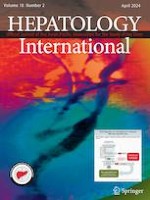Published in:

20-11-2023 | Hepatocellular Carcinoma | Original Article
Transferrin receptor 1 promotes hepatocellular carcinoma progression and metastasis by activating the mTOR signaling pathway
Authors:
Fu Wang, Wei-Qi Xu, Wan-Qin Zhang, Ru-Chen Xu, Jia-Lei Sun, Guang-Cong Zhang, Zhi-Yong Liu, Zhuo-Ran Qi, Ling Dong, Shu-Qiang Weng, Xi-Zhong Shen, Tao-Tao Liu, Ying Fang, Ji-Min Zhu
Published in:
Hepatology International
|
Issue 2/2024
Login to get access
Abstract
Background
Aberrant iron metabolism is commonly observed in multiple tumor types, including hepatocellular carcinoma (HCC). However, as the key regulator of iron metabolism involved in iron absorption, the role of transferrin receptor (TFRC) in HCC remains elusive.
Methods
The mRNA and protein expression of TFRC were evaluated in paired HCC and adjacent non-tumor specimens. The correlation between TFRC level and clinicopathological features or prognostic significance was also analyzed. The role of TFRC on biological functions was finally studied in vitro and in vivo.
Results
The TFRC level was remarkably upregulated in HCC tissues compared to paired peritumor tissues. Overexpressed TFRC positively correlated with serum alpha-fetoprotein, carcinoembryonic antigen, and poor tumor differentiation. Multivariate analysis demonstrated that upregulated TFRC was an independent predictive marker for poorer overall survival and disease-free survival in HCC patients. Loss of TFRC markedly impaired cell proliferation and migration in vitro and notably suppressed HCC growth and metastasis in vivo, while overexpression of TFRC performed an opposite effect. Mechanistically, the mTOR signaling pathway was downregulated with TFRC knockdown, and the mTOR agonist MHY1485 completely reversed the biological inhibition in HCC cells caused by TFRC knockdown. Furthermore, exogenous ferric citrate (FAC) or iron chelator reversed the changed biological functions and signaling pathway expression of HCC cells caused by TFRC knockdown or overexpression, respectively.
Conclusions
Our study indicates that TFRC exerts an oncogenic role in HCC and may become a promising therapeutic target to restrain HCC progression.





